Foundations of the SBA theory: Pre-(to) Mid 20th century
Psychotherapy perceived as a forum during which the therapist deciphered a client’s problem and then proceeded to solve it with expert psychological theories and skill.
Emphasis was laid on the problem and the causes, which were believed to stem from troubled childhoods and so the patient stored them in the deep recesses of his or her psyche. This theory informed most of the treatment procedures aimed at retrieving thoughts from the sub-conscious e.g. hypnosis, dream analysis and interpretation, drugs and other projective techniques.
Therapy was usually long and unfocussed in that it lacked pragmatism and definite goals. Patients went for therapy for decades without noticing any major developments partly because they did not know what improvements to look out for.
In this era, the dominant psycho-therapeutic procedure was that which was established by Sigmund Freud that divided the mind into three parts, the conscious, the subconscious and the ego.
The thoughts believed to cause psychological issues resided in the subconscious and the best way to retrieve these was by ensuring the subject was unconscious then the therapist would tap into their mind using various extraction techniques including hypnosis and dream harvesting.
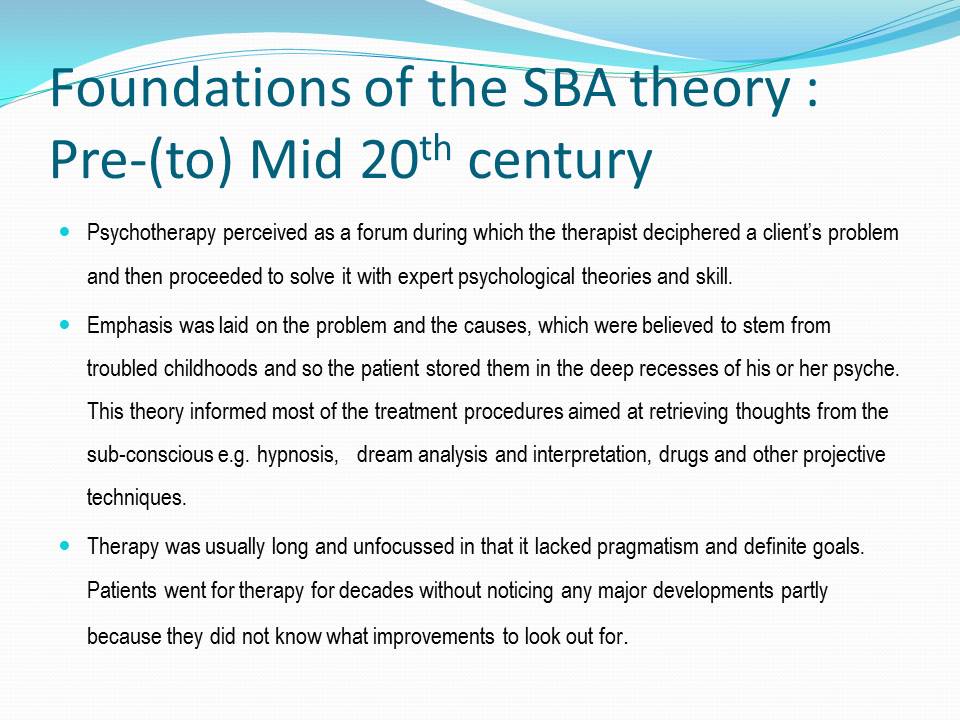
Foundations: Middle of 20th century and beyond
Therapists and patients alike soon began to seek better ways of issuing and accessing therapy that was brief, goal-oriented and pragmatic.
Behaviorism took root as it was distinguished from psychoanalysis since it emphasized on intervening in concrete observable behaviors.
Albert Ellis founder of the more pragmatic Rational Emotive Therapy (RET) postulated that psychological problems were caused by irrational beliefs held by patients and if these beliefs could be identified and discarded and replaced with more rational ones, the problem would be solved.
William James (1842-1910) is known as the father of pragmatism. He believed that people are creators of reality and that if therapists stopped focusing on explaining and predicting truth and instead focused on identifying what works, they would be way ahead.
It soon became apparent that these methods were ineffective especially because patients were subjected to years of therapy without any visible healing taking place. The patients themselves began to discredit the psychotherapy and those that were desperate learned how to ‘be’ their diagnosis: so that it appears that treatment halted upon establishment of the problem. Nevertheless, this ‘problem-identification’ is dubious at best because it was established on the basis that all problems stemmed from disturbed childhoods. The theory did not consider that perhaps the problems were simply manifestations of bad behaviors presently.
Behaviorism came as a neo-solution and it made psycho-therapists seriously consider patients’ behavioral patterns including the thought processes that were defective to their mental health.
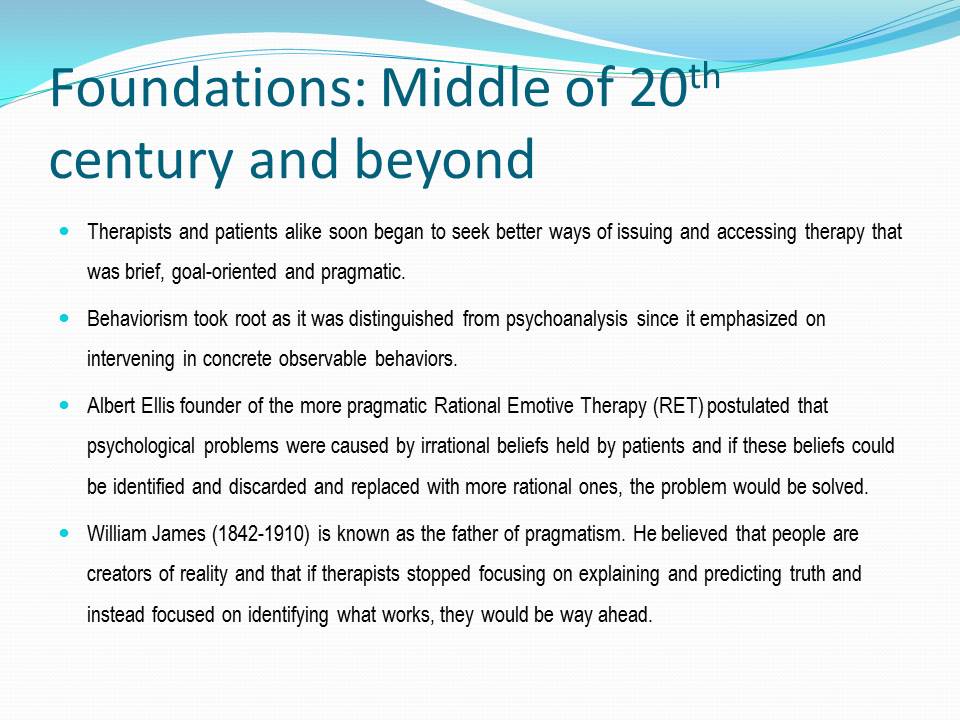
Foundations: Genesis of the Solution Based Therapy
Milton Erickson: an unorthodox therapist whose ideas were very successful in his era. He believed that people could solve their own problems and encouraged patients to look to their social resources for solutions. He de-emphasized diagnosis of problems and instead capitalized on the anticipated solution. He noted that half his patients had already began solving the problem when they came in for therapy.
This was a radical because he went completely against the grain and suggested that people were wired to solve their own problems. Traditional psychologists opposed him, not only because he caused them to lose clients but also because his ideas had merit but they lucked theoretical backing.
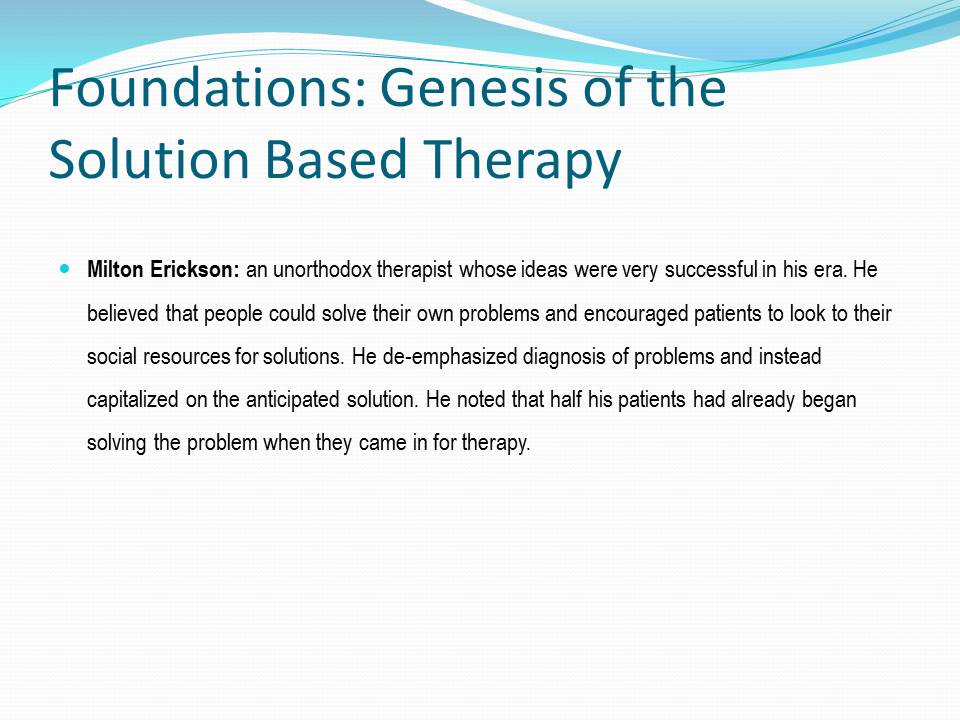
Insoo Kim Berg and de Shazer
- One-way screen: this was initially de Shazer’s project whereby he (or a team of therapists) observed the patient with the therapist in conversation without the notice of either party. After some time, the therapist came behind the screen and the tip gave pointers and observations which the therapist went back to relay to the patient as feedback.
- Ethical Dilemma: the lack of confidentiality characteristic of this practice caused a lot of upheavals from traditional therapists and eventually Berg and de Shazer broke off to start their own practice-The Brief Family Therapy Center (BFTC) in Milwaukee, Wisconsin 1978.
- Mental Research Institute (MRI): Inspired by the controversial works of these psychologists, Berg joined the Mental Research Institute for further studies and Weakland became her mentor. Co-incidentally, Weakland’s mentor was de Shazer and eventually, Berg and de Shazer were introduced and they started working together.
In a way, this was a development of Erickson’s theory. Erickson had been wiped out in his era but here were psychotherapists reviving his theory albeit posthumously. What is interesting is that the motives at both times were different, with Berg looking to find a working solution that required only brief therapy. However, it is also interesting to note that De Shazer’s motives were not married to Berg’s at the time. If anything, he was not necessarily considering psychotherapy while working on George Bateson’s project, which is one that gave a lot of insight to the Solution Focused Approach to therapy. Anyhow, eventually there was a meeting of minds as to the desired outcome which was to find out what works in psychotherapy.
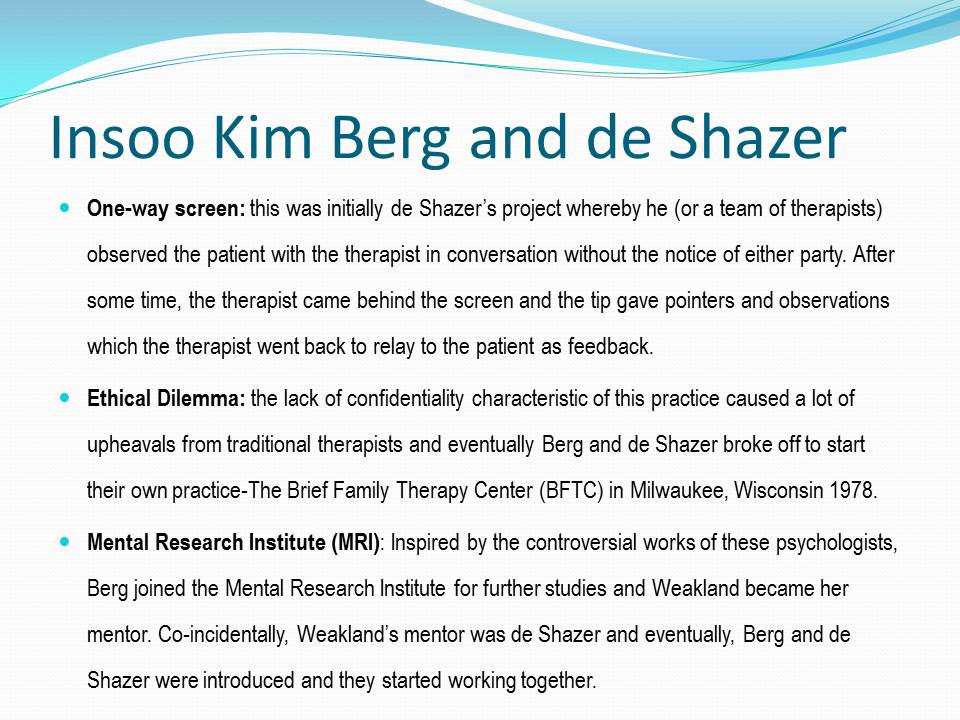
Coming to the theory
Insoo Kim Berg: an American therapist with Asian origin. Asia is a collectivist continent hence diverting from the accepted goal dictated by family and community was precarious. However, Insoo felt that traditional therapeutic approaches were not working and dared to go against the grain. She was further inspired by Jay Haley’s texts, namely: “The power tactics of Jesus Christ” and “Uncommon therapy” among others. At the time, Haley was working at the Mental Research Institute with other famous think tanks like John Weakland and Paul Watzlawick.
Initially, the creators of SBA did not have a working hypothesis because they wanted to establish what works in therapy from scratch and not build on existing traditional approaches that were proving ineffective.
A close look at Hofstede’s theory on culture reflects the characteristics of a collectivist culture, which Berg hailed from. Such a perspective assists us in understanding the cultural obstacles she must have faced when she dared to defy what has come to be established as tradition in psychotherapy. What she was in fact doing was foregoing the interest of the majority psychotherapists to pursue an untraveled terrain whose propositions at the time were nothing short of prop estrous! However, she was wise about it especially because they did not pinpoint a particular theory on the onset. Looking at solution focused therapy presently, this wisdom is apparent because it is mostly a volatile practice which depends on the patient in front of you and their perspective of reality.
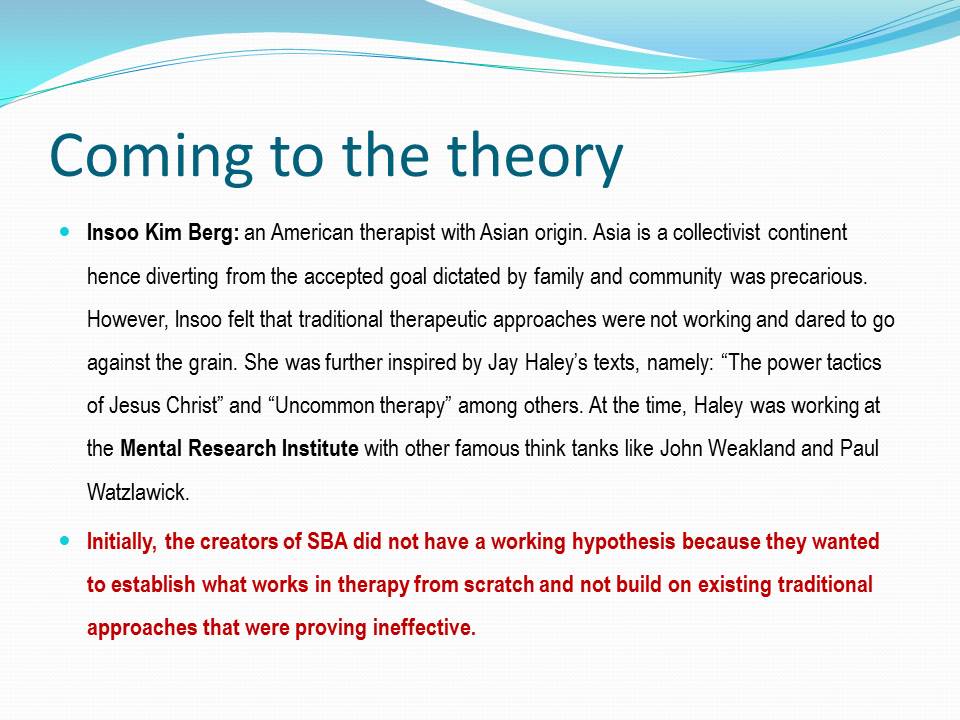
Main beliefs
- If it is not broke [in the patient’s mind] do not fix it- this encourages non intrusion or non-interference by the therapist on matters not related to the problem at hand.
- Once you know what works, do more of it.
- If something does not work, don’t do it again, do something different- SFT is largely experimental and therein lies its beauty because the fact is, each patient is unique and what works for patient A will not necessarily work for patient B. consequently, therapists should be ready try and fail severally before they find a working solution for each patient.
- Start with the end in mind- this touches on goal setting at the onset so that both therapist and patient are aware of the desired outcome and work towards it including intermittent evaluations.
It is clear from the onset that this approach lays emphasis on the patient and their needs. The expertise of the therapist takes a backseat as the patient is given the opportunity to relay the problem as he or she perceives it.
It is also largely experimental because what works for one patient will not necessarily work for another (Dejong & Berg, 1998, p.221).
Finally, the desired outcome is what guides the procedure of treatment. This is because even if one looks at the name- Solution-Focused approach, the solution is what is significant to both patient and therapist.
- The patient in a therapy session is not opposed to the idea of receiving help to reach a solution and so the alleged resentment that traditional therapists believed existed and acted accordingly is to be dispensed with.
- The emphasis should be on the client and his life. The client should do most of the talking in any given session because he or she is aware of the problem, the cause and possible solutions, the therapist’s role is simply to direct the patient.
- A focus on the problem and its cause is unproductive because we cannot change the past. Instead, therapists should steer patients’ concentration away from the problem and onto possible perceptible solutions.
This approach frowns upon the traditional perspective of patients resenting therapy and thereby resisting treatment. Instead, it postulates that the patient often has recognized a problem and when he or she makes an appointment with the therapist, it is because he or she is seeking a solution to the conundrum. Seen against this background, the patient is a very cooperative party in the treatment process who can actually be relied upon to come up with meaningful suggestions especially in terms of exceptions.
Secondly, the basis of this approach is the nature of change, which is constant and is brought about by the passage of time. As such, the therapist makes the patient understand that the past is permanent and cannot be changed and it is far wiser and more effective to focus on improving the future. This means that the focus is on solutions and not on the problem.
- The therapist cannot on his own come up with a viable solution, the patient has to arrive at solution using the map given to him by the therapist and social resources available to them.
- It is not ideal to time the lasting period of therapy i.e. this approach prefers a brief therapy and so it does not prescribe the number of sessions. Instead, the patient and therapist set goals based on desired outcomes or solutions rather than time.
- Pre-session change two thirds of the patients that see counseling or therapy have already began to solve the problem on their own before they attend their first appointments. It is important to capture the change they have accomplished unselfconsciously an use it to trigger or motivate future change.
This pre-session change serves to build upon Erickson’s assertions that people are built to solve their own problems. It is also apparent in the identification of exceptions as the patient will ear-mark periods when the problem seemed less intense because they were coping well. The therapist only serves to highlight such breakthroughs and then coach the patient to make them a habit and thus the problem recedes.
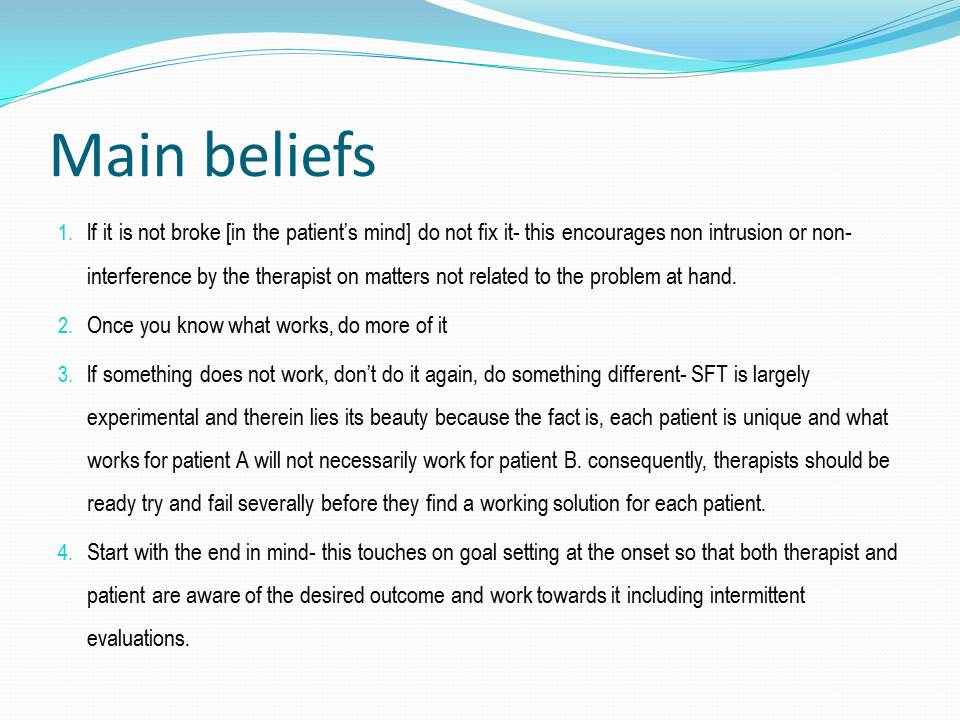
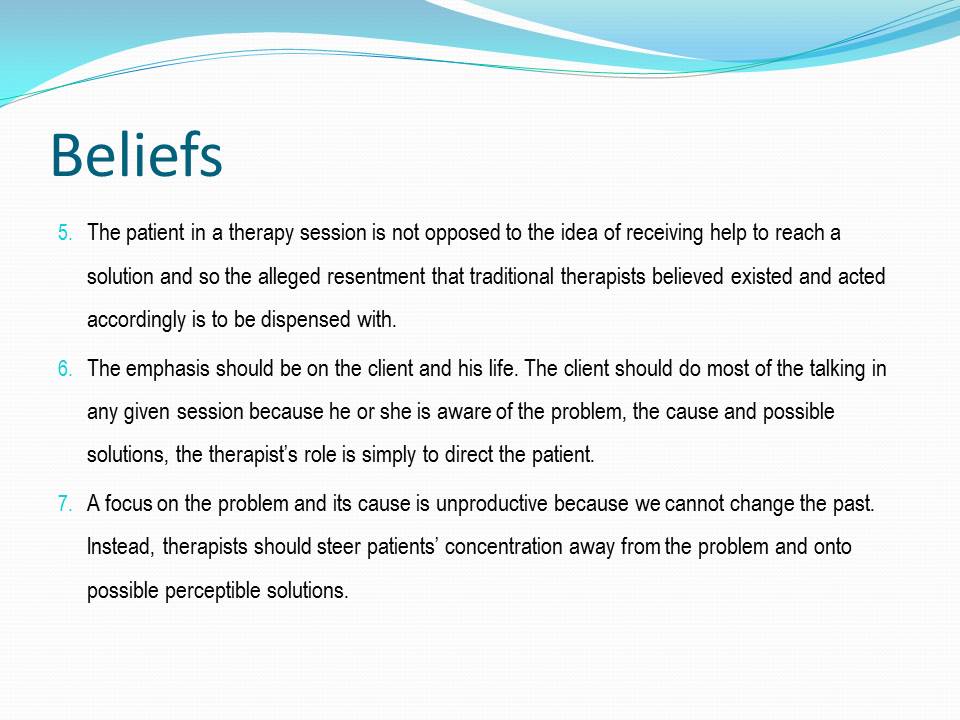
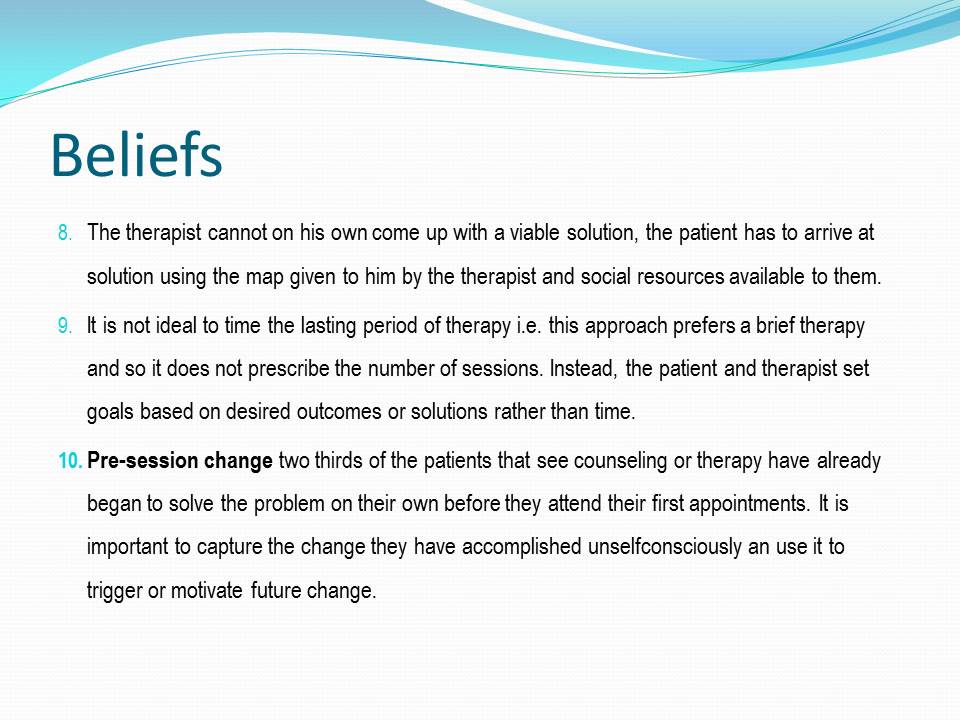
Development of SBT: 1978-1985
These years marked the creation of the basis of the solution based approach to therapy.
Financial hardships and guiding objective: at this point, Berg and De Shazer barely had enough money to support themselves and their living room sufficed for an office. Their main objective was to find out what worked in therapy.
De Shazer’s publications
Patterns of Brief Family Therapy: An Ecosystemic Approach – book published in 1982.
The Death of Resistance (De Shazer, 1984) first published in 1979 but rejected by journals 17 times: this article rejected the idea that patients secretly resent therapy and reinforced the notion that they seek therapy in a bid to cooperate with the therapist in finding a solution for their problems.
Just like Erickson before them, Berg and De Shazer experienced seemingly insurmountable difficulties convincing their colleague elites that they had a better way to conduct therapy. The traditional approach was set in stone and breaching it made them culpable for theoretic crime. They were shunned and De Shazer’s first publication took five years and seventeen attempts to get published in a peer reviewed journal, and even then, it was taken with a pinch of salt.
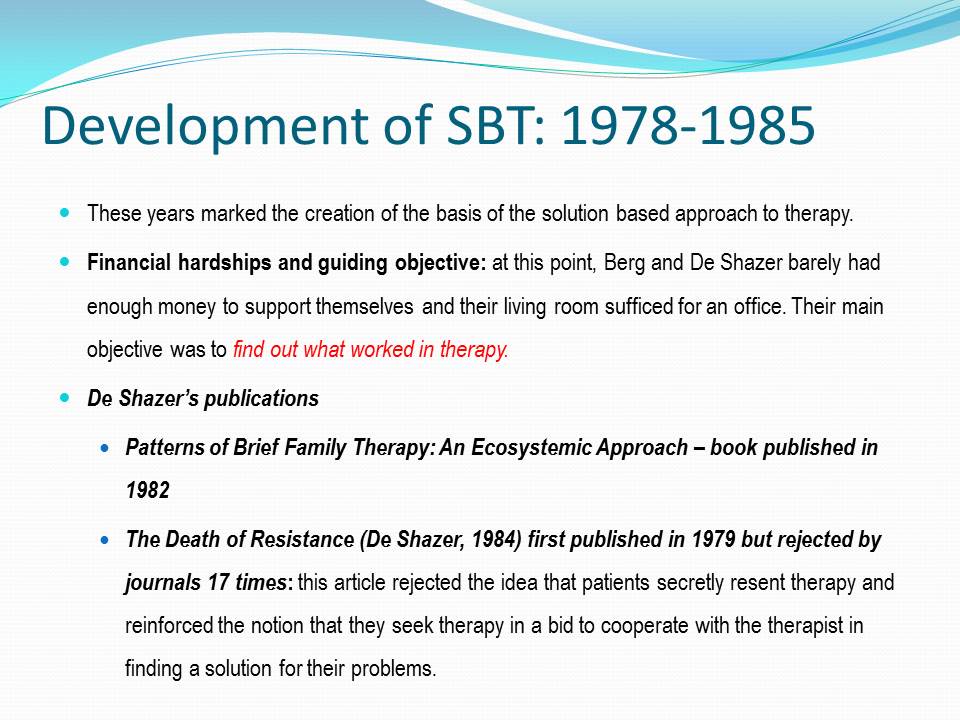
Techniques used in Solution Based Therapy
- Four useful interventions in brief therapy, which he co-authored with Alex Molnar in 1984- this article introduced the First Session Formula Task which involves therapists asking patients to go home and analyze the good things happening in their lives that they would like to continue happening.= the continuation question.
- A second intervention discussed in this article was “Do something different” founded upon behaviorism concepts of George Bateson. This encouraged patients to change the way they acted and look out for better results.
- A third intervention technique was the “overcoming-the-urge task”, which required patients to pay attention to how they managed to curb an act they were complaining about.
These initial publications are significant for the foundation they set for what came to be known as the Solution focused approach to therapy. Presently, they inform the clinical steps undertaken in the execution of this kind of therapy.
- The stability as change intervention which was motivational where a patient felt that they were stuck in the same situation. The therapist noted that it required myriad skills to remain stable and numerous people would have fallen back already.
- Keys to Solution in Brief Therapy was De Shazer’s second book and in it he emphasizes the need to grow accustomed to change; the unimportance of dwelling on problems in attempting to solve them; and the significance of past successes as a key to solving present problems.
- An indirect approach to brief therapy, a chapter in the book introduced the concept of “scaling questions”, an intervention technique that requires the client to grade himself on a scale of 0-10 in terms of the ideal situation when the problem is solved and the current position
These initial publications are significant for the foundation they set for what came to be known as the Solution focused approach to therapy. Presently, they inform the clinical steps undertaken in the execution of this kind of therapy (De Shazer, 1991, p. 431).
- Scaling questions also touch on the peaks achieved by the client in the past in case the problem is caused by a relapse. The client is required to examine how his situation was at the time of such a peak and identify possible solutions to the current problem.
- Between 1986 and 1987, the “What’s Better?” question took root. It was asked at the onset of the second and later sessions and it gave the clients a chance to focus entirely on the positive facets of their life and feel motivated through this positive review.
- The concept of Exceptions took root when the therapists discovered that problem intensity tended to fluctuate and that at times it was severe while other times it was not as pronounced. They thus encouraged patients to take note of the situation including their actins during the less severe times and try repeat these conditions in a bid to reduce the intensity of the problem and have it fade to the background.
These initial publications are significant for the foundation they set for what came to be known as the Solution focused approach to therapy. Presently, they inform the clinical steps undertaken in the execution of this kind of therapy.
Scaling is now used even beyond psychological circles, so is the miracle question.
- The Miracle Question invented by Insoo Kim Berg is a very popular intervention technique that requires the patient to imagine that in the dead of the night a miracle occurred and the problem magically vanished then tell the therapist what would be different.
- In Clues, Investigating Solutions in Brief Therapy, 1988 De Shazer introduced the concept of prediction tasks that required patients to predict what they thought they would accomplish the next day regarding their current problem. This concept is based on the idea that setting out a plan to solve the problem is solving it halfway.
- Reframing: this involves reverting negative and positive perspectives of a crisis so that instead of looking at a problem as purely negative, one looks at the good intentions and probably genius skill invested therein.
Reframing is also known as restructuring and its genius is in the creation of a non-prejudicial atmosphere that is both necessary and conducive for objective therapy (Guterman, 2010, p.67).
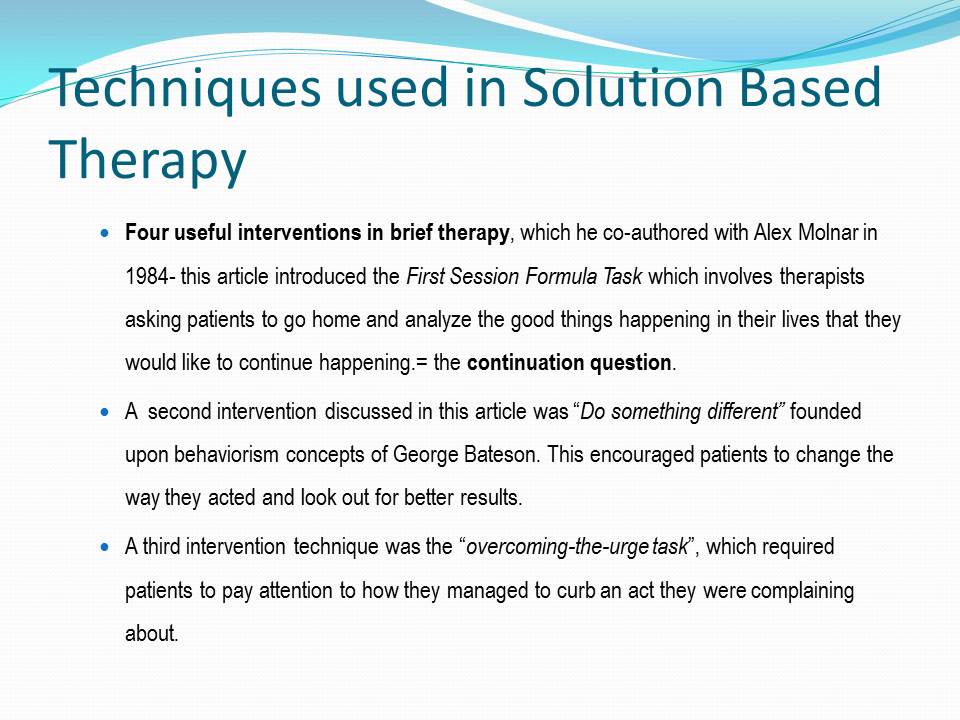
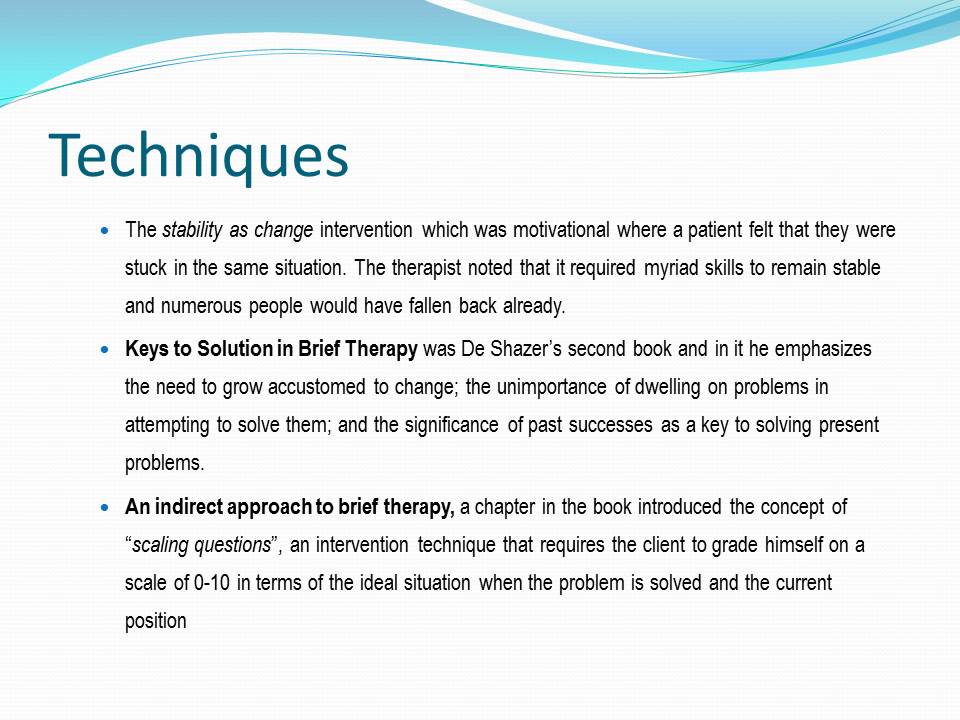
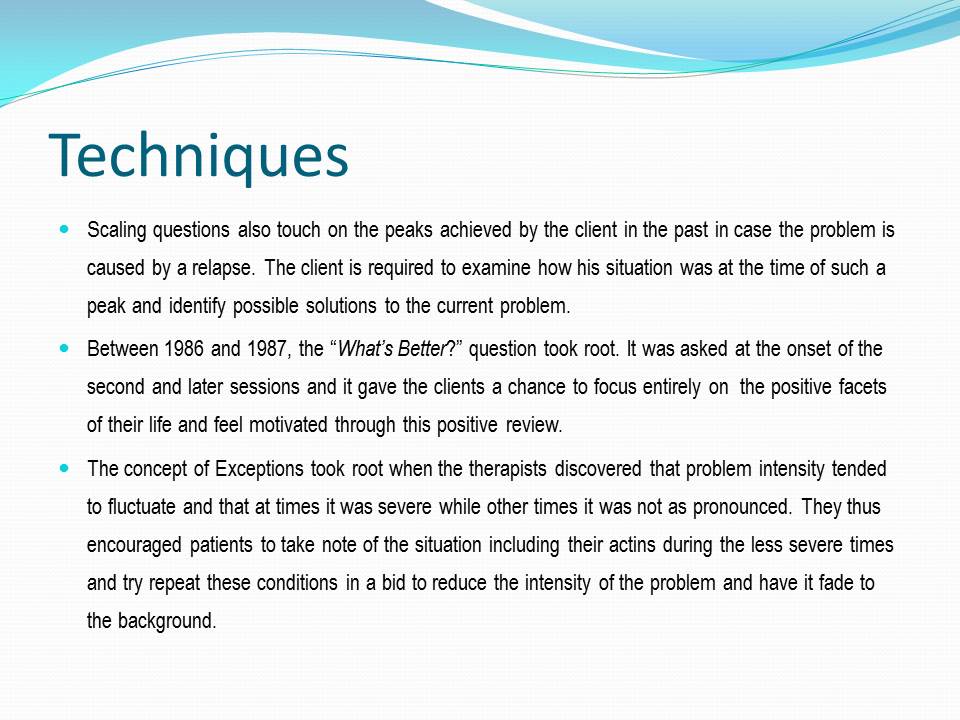
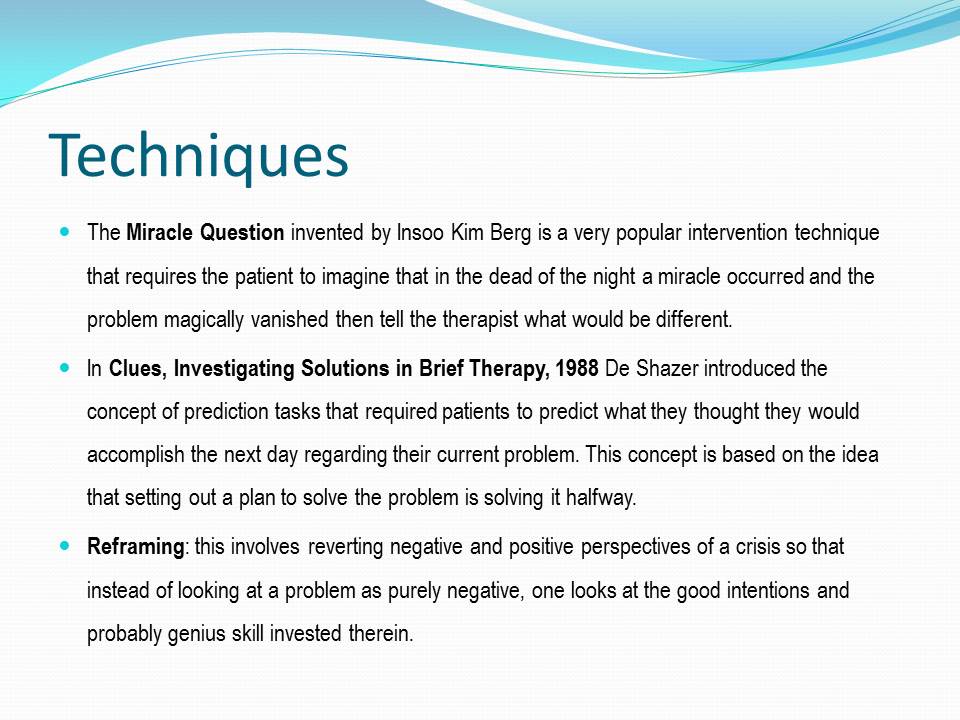
Classification of clients
- Visitors: these are they that do not have clear expectations from the therapy program. They are mostly there involuntarily ad they do not believe the sessions will work. At times they do not even seem to know their problem.
- Complainers : these are they that have reckless behavior and are lazy in coming up with solutions. They enjoy talking to the therapist to enumerate their problems and seek pity but retract when the therapist suggests that they work towards a particular solution. They seem blind to the cause-effect relationship between their conduct and the problem and as such cannot even begin to imagine how their behavior is relevant to the solution.
- Customers: the ideal patients that understand why they are in therapy. Co-operate with therapists to find and try out solutions while reporting back on their effectiveness.
The idea is to have the therapist convert a patient from a visitor to a complainer nd eventually to a customer.
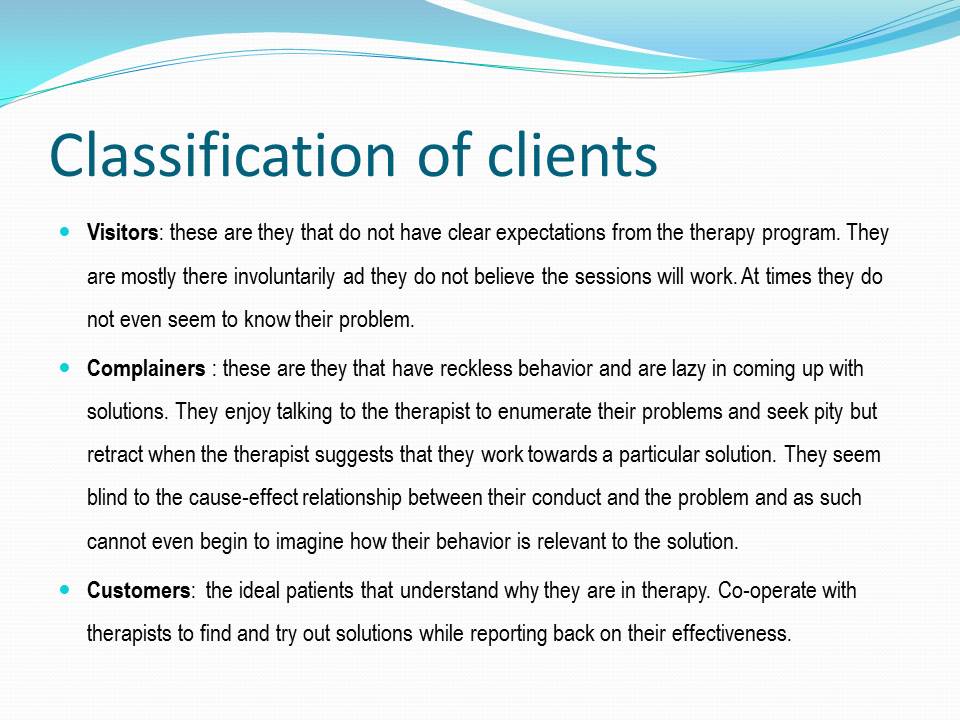
Clinical steps for SFT: Step 1- Problem and Goal
Co-constructing a Problem and Goal
The problem definition should fit the patient’s worldviews. The therapist should be cautious not to “create a problem” where the client does not envisage one. The therapist should take care not to impose pathological problems on the client where they do not exist.
Ideal questions:
- What is your understanding of what brings you here today? (for problem identification)
- What would you like to accomplish through therapy? (for goals)
The issue of world views cannot be overemphasized as there are two contrasting views of realities at play: the patient’s and the therapist’s. this approach gives credence to the former over the latter by applying the “not knowing” mentality to the therapist that requires him or her to assume the patient knows it all as far as the scope of the problem is concerned, hence the initiating question: “What is your understanding of what brings you here today?” this gives the patient and therapist a chance to derive optimal results from the sessions.
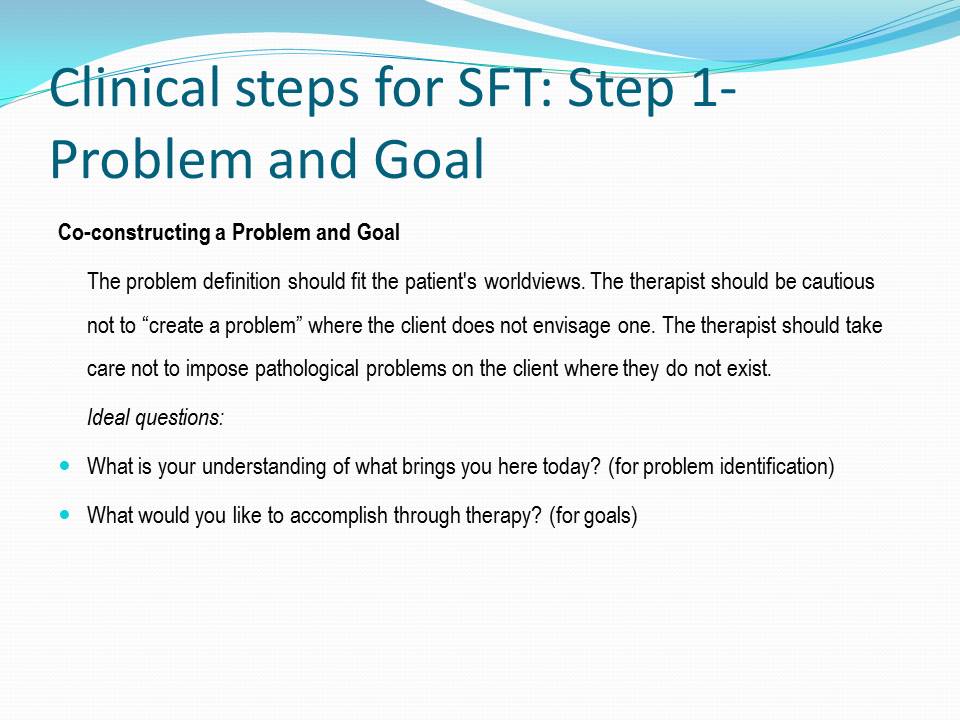
Step 2: Exceptions
Identifying and Amplifying Exception
Question: “When has there been a time when you coped better with the problem?”
The effect of this question is to have the patient look back at times when the problem did not seem so severe and reflect back on how they were coping at the time. The idea is that problems are always fluctuating and at times they are more severe whereas at other times they are not so serious. A knowledge of previous coping skills can help in finding a solution faster.
Exceptions are those ups in the problem’s lifespan where the patient can acknowledge having gained some leverage over the issues they were facing. By capitulating on these, they can form through conjoined exceptions a solid solution as they practice curative exceptions over time.
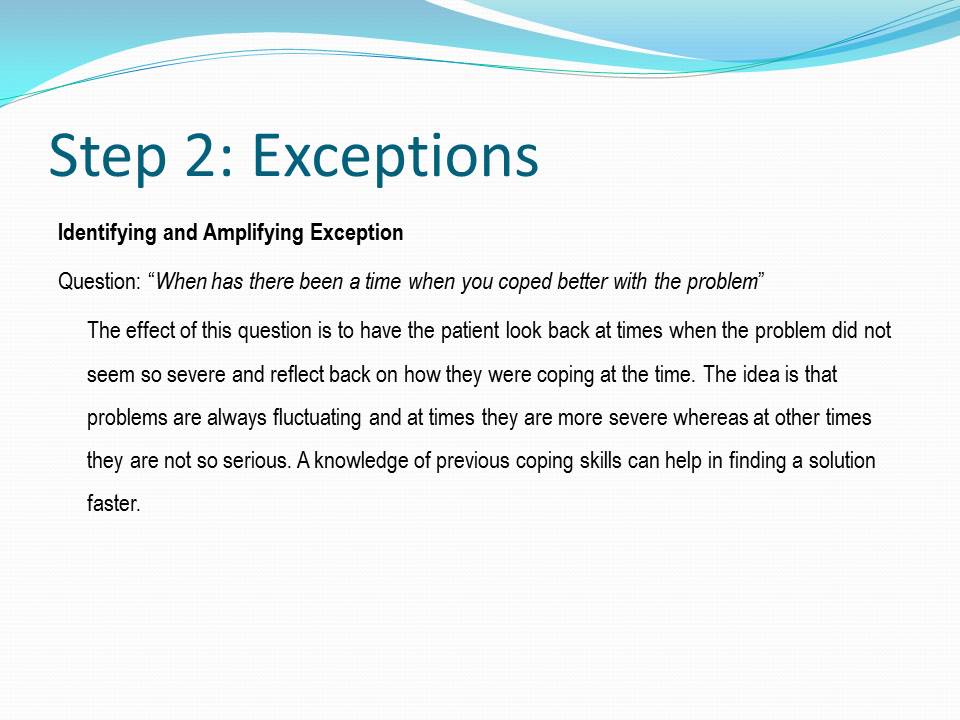
Step 3: Assigning Tasks
- This step aims at building on the problems, goals, exceptions, and potential exceptions established in the previous sessions.
- The idea is that the therapist assign the task requiring practical effort depending on the patient’s answers previously.
- If the patient identified exceptions, the therapist can give a task to continue to practice the exception and report back on a scaling level.
- It is important that the task assigned be meaningful to the patient or in the patient’s opinion in view of solving the problem and achieving the desired end.
It is important that the task assigned be meaningful to the patient or in the patient’s opinion in view of solving the problem and achieving the desired end.

Step 4: Evaluating the Effectiveness of Tasks
- Involves the identification and amplification of exceptions established through the tasks assigned in the previous sessions.
- In case of negative feedback such as a client reporting that he did not do the task, the therapist should avoid the resistance by letting that slide and then probably going back to the starting point of the previous session. At times such negative feedback is insightful to the therapist because it means that the client was not intrigued by that type of task and a reassessment is necessary.
- For couples and families, this session is marked by a re-focus o the problem. The therapist should carefully steer the patient (s) away from the problem and ask to address the task assigned at the last session then later re-evaluate the problems and goals.
At times such negative feedback is insightful to the therapist because it means that the client was not intrigued by that type of task and a reassessment is necessary.
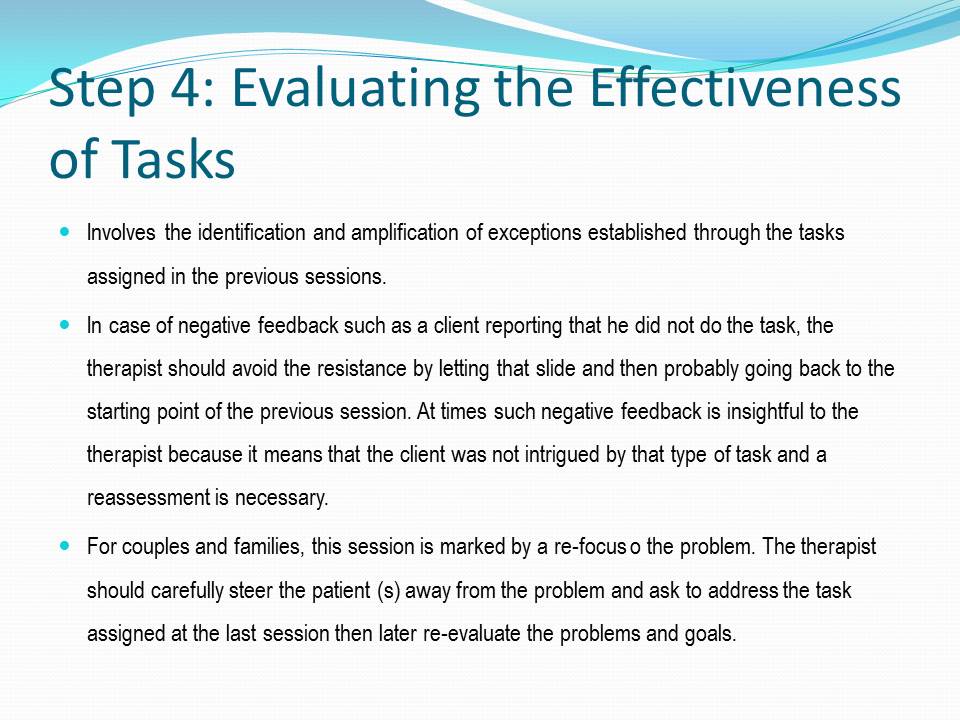
Step 5: Reevaluating the Problem and Goal
- At this point, the therapist and his/her patient re-evaluate the problem and goal.
- The idea is to see how much the exceptions are panning out as sufficient solutions to the problem, or how much they have been instrumental in achieving the desired outcomes.
- If the solution is satisfactory, the therapy ends here. If not, the problem and goals are reconstructed and therapy begins again.
The idea is to see how much the exceptions are panning out as sufficient solutions to the problem, or how much they have been instrumental in achieving the desired outcomes.
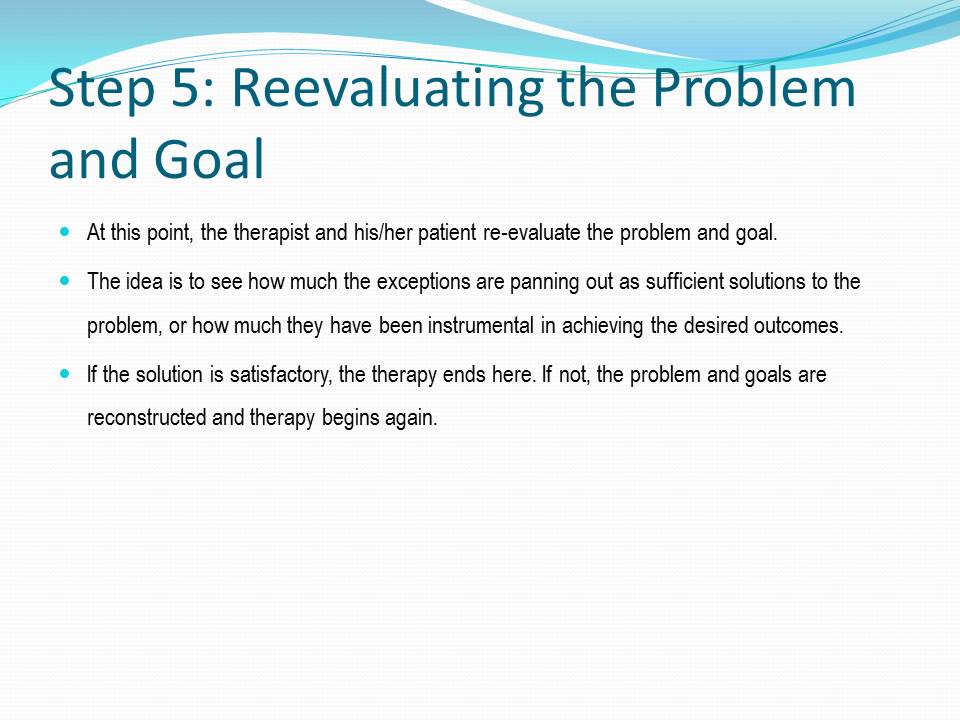
Other authors’ contributions to the theory
Eve Lipchik came up with two key concepts:
- The coping question – “How do you manage to go on?” this helps when the patient is feeling particularly despondent and perhaps rates themselves at zero on the scale.
- Listening with a constructive ear – related to De Shazer’s Death of Resistance Idea and it requires the therapist to adopt an appreciative palate on which to receive information and at times, this means looking at the good intentions that resulted in bad situations.
Harlene Anderson and Harry Goolishian (1992) formally introduced the idea that a therapist should listen to the patient with an attitude of “not-knowing” as opposed to being an expert in that field.
Eve Lipchik came up with two key concepts viz. the coping question and listening with a constructive ear (DE Shazer, Berg, & Lipchik, 1986, p. 209). However, Harlene Anderson and Harry Goolishian formally introduced the idea that a therapist should listen to the patient with an attitude of “not-knowing” as opposed to being an expert in that field.
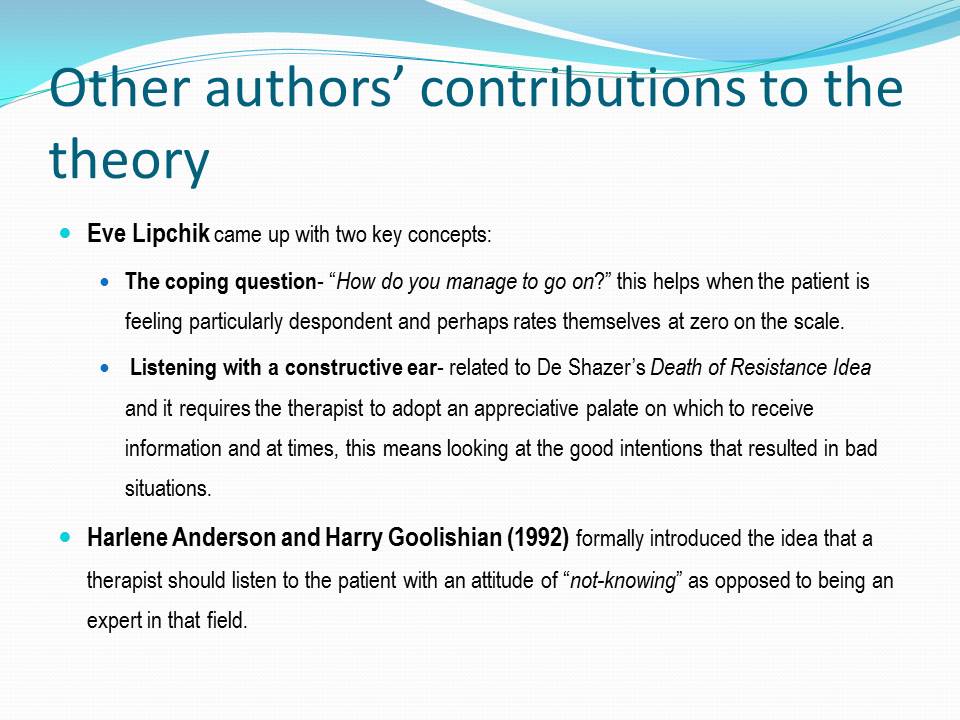
Strengths of the theory
Flexibility allows growth of theory and therapist in scope and knowledge respectively:
- Since this theory is very general in its scope and the guiding principle is that the therapist should observe each individual patient to decipher what works and what does not, it gives room for potential growth of the theory and the area of psychology.
- Additionally, it allows individual therapists to grow in their professional capacities as they discover latent ideas while visiting with patients.
Ignorance of therapist encourages disclosure and optimal solutions:
- Since the therapist is required to adopt a “not knowing” attitude, he is less biased t the patient’s dilemma and thus less likely to impose upon the patient pathological problems. This enhances patients’ confidence and stimulates full disclosure leading to optimal solutions.
Additionally, it allows individual therapists to grow in their professional capacities as they discover latent ideas while visiting with patients.
Self-initiative of client and respect of client’s mental state (if it is not broke [in the client’s mind] do not fix it).
Specificity in goal formation the authors of this theory have come up with a very specific model for goal formation that in turn churns out specific goals that are relevant to the problem, measurable, attainable, realistic and time-bound.
Brevity and precision:
- The main idea is that this approach be pragmatic and deliver results within a short time. This is why it has five brief and rather simple steps which can easily be completed within a month or less and rewound without any real harm.
The Solution focused approach is famed for its brevity. It is important to distinguish this feature from the term short- term because the latter depicts an element of timing that is mostly absent from the solution based approach, whose definitive feature is the emphasis on solution rather than period of therapy.
Additionally, the concept of not guessing the patient’s problem comes to mind stemming from the qualification “in the client’s mind.” this denotes a tendency to let the patient spell out the problem as they perceive it.
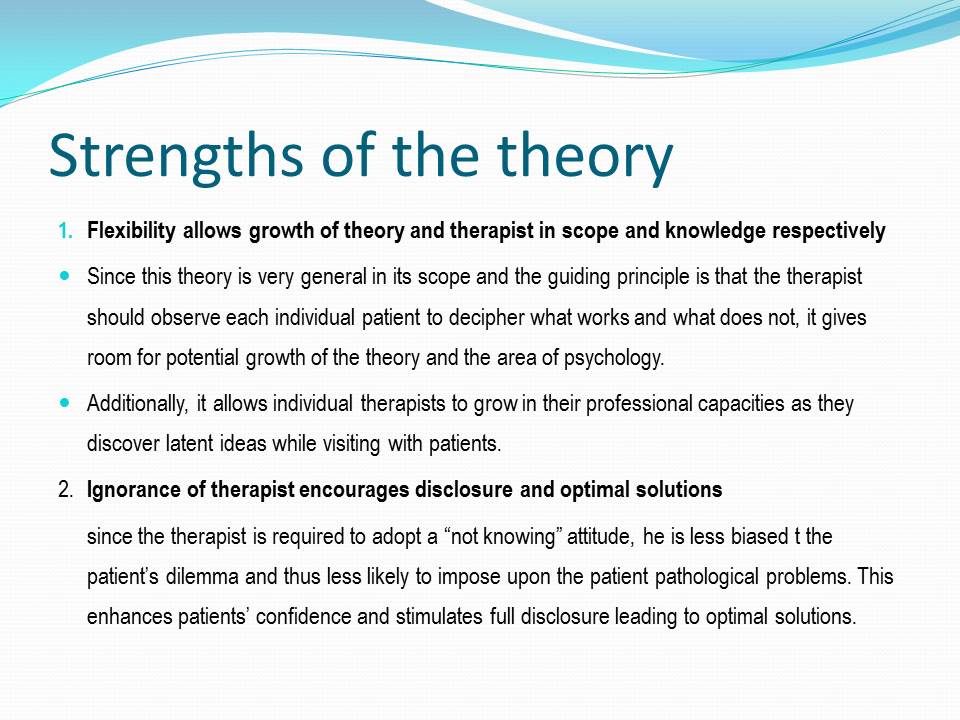
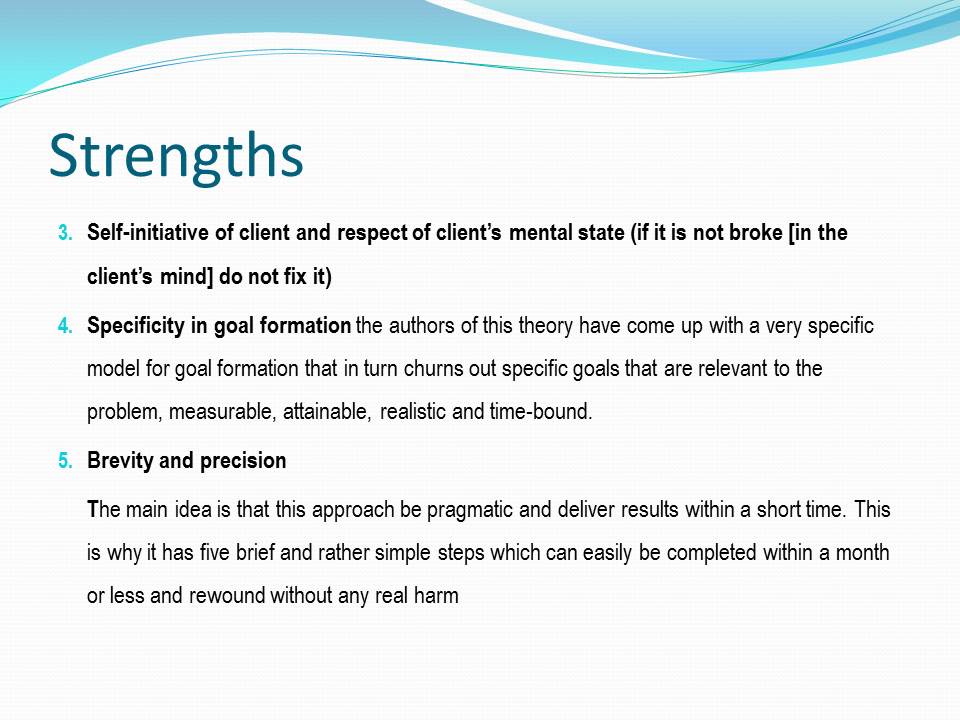
Weaknesses
- Novelty: this method of therapy is still in its formative years and as such, it has not been weathered over time by research and experience. This novel status somewhat removes from its credibility.
- Lack of detailed research comparing it to other models makes using t as a supplement or complement difficult
- Relativity of ‘reality’ creates a barrier between the therapist and the patient’s understanding of the problem and perceived solution due to difference in world views.
The formal term solution focused approach finds its genesis in the nineteen eighties. As such, it is a most less than half a century old and this makes it less credible than the centuries-old traditional approach. As such, convincing the world of its credibility despite the lack of exhaustive research and theories is a taxing task.
Secondly, the issue of world views cannot be overemphasized as there are two contrasting views of realities at play: the patient’s and the therapist’s. this approach gives credence to the former over the latter by applying the “not knowing” mentality to the therapist that requires him or her to assume the patient knows it all as far as the scope of the problem is concerned, hence the initiating question: “What is your understanding of what brings you here today?” this gives the patient and therapist a chance to derive optimal results from the sessions.
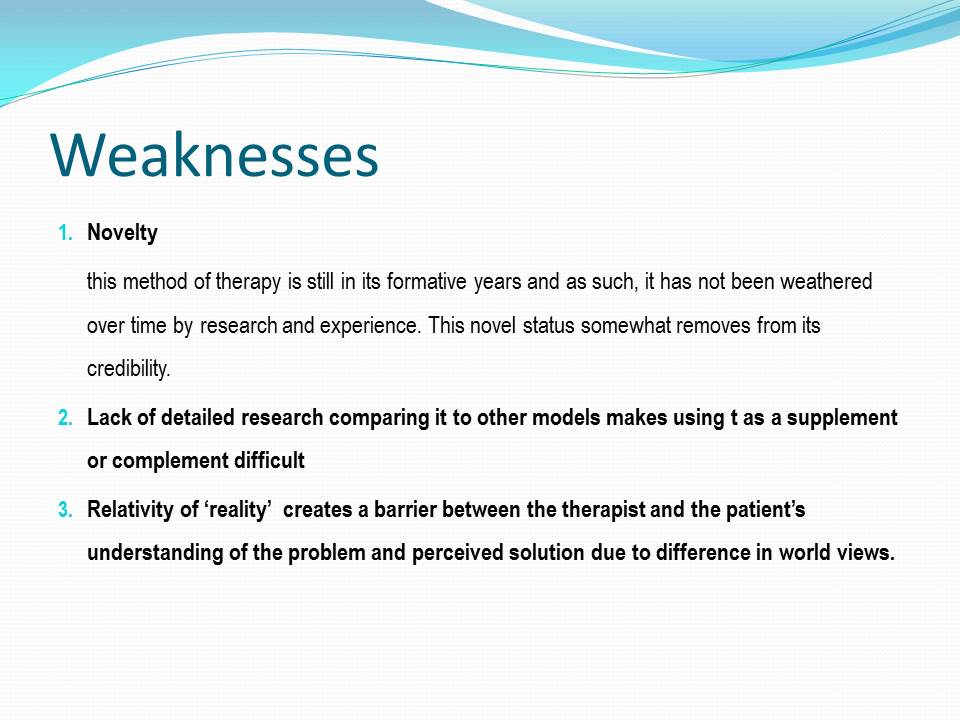
Summary
- The solution focused approach to therapy is attractive due to its brevity, precision, and pragmatism. The main developers of this school of thought are Insoo Kim Berg and Steve de Shazer.
- Its emphasis is on the solution and the future instead of the problem causes that are present in the past. However, it advocates for a review of the past to identify exceptions, which are defined as point in time when the problem was not so pronounced due to a particular coping mechanism by the patient.
- These exceptions form the building blocks of the tasks assigned by the therapist to the patient with a view of achieving the desired outcomes.
- It is still a new field of psychoanalysis.
The solution focused approach to therapy is attractive due to its brevity, precision, and pragmatism. The main developers of this school of thought are Insoo Kim Berg and Steve de Shazer. Its emphasis is on the solution and the future instead of the problem causes that are present in the past. However, it advocates for a review of the past to identify exceptions, which are defined as point in time when the problem was not so pronounced due to a particular coping mechanism by the patient. These exceptions form the building blocks of the tasks assigned by the therapist to the patient with a view of achieving the desired outcomes.
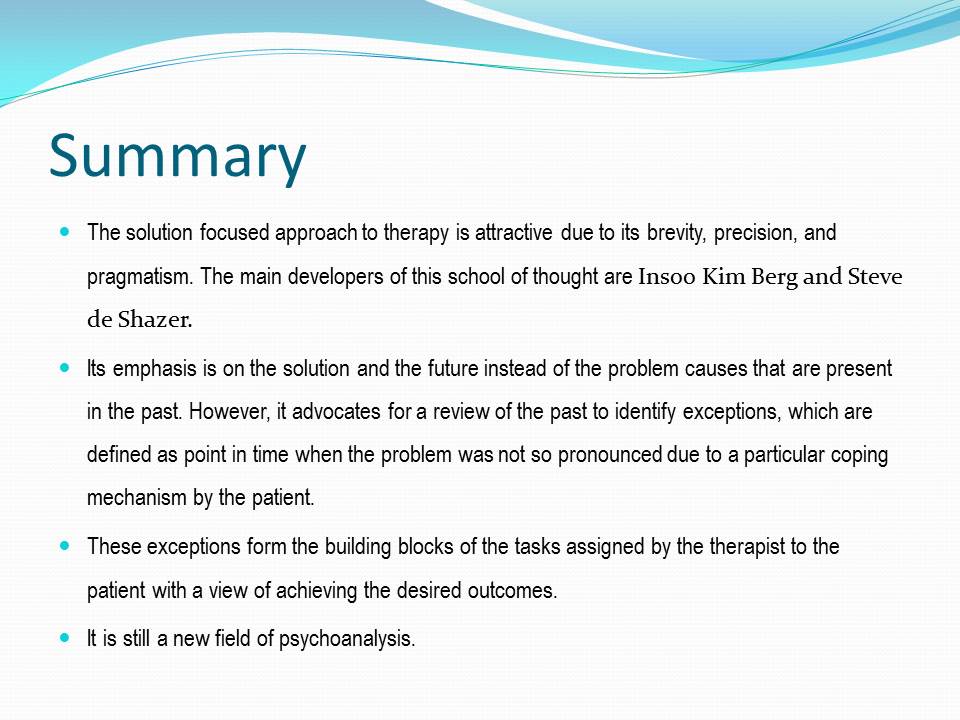
References
DeJong, P., & Berg, I. (1998). Interviewing for Solutions. Pacific Grove, CA: Brooks/Cole Publishing Company.
De Shazer, S. (1991). Putting difference to work. New York, NY: Norton.
De Shazer, S., Berg, I., & Lipchik, E. (1986). Brief Therapy: Focused Solution Development. Family Process, 25, 207-221.
Guterman, J. (2010). Advanced Techniques For Solution-Focused Counseling. Web.